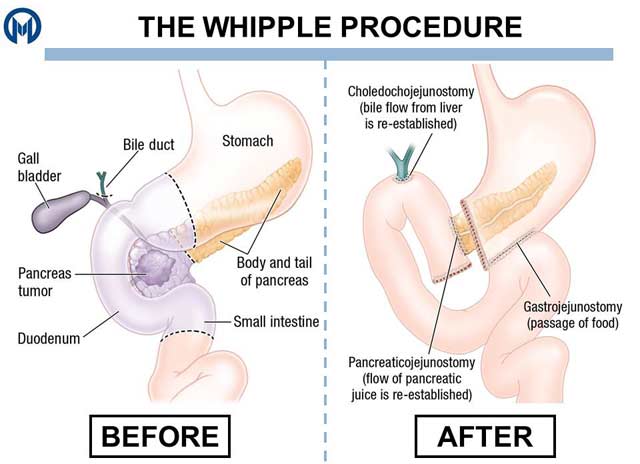Whipple Procedure: Pancreatic Cancer Surgery Treatment

A Whipple procedure, or pancreaticoduodenectomy, is the most common type of surgery performed to address pancreatic tumors. Named for Dr. Allen Oldfather Whipple, the surgeon who designed and first performed this surgical technique in 1935, the Whipple procedure has continually improved over the years and can potentially enhance outcomes and quality of life for patients with pancreatic cancer.
While there are several variations in approach, a standard Whipple procedure involves the surgical removal of:
- The head and sometimes the neck of the pancreas
- The surrounding lymph nodes
- Portions of several nearby structures, such as the gall bladder, bile duct, duodenum, small intestine and stomach (antrum), if those organs are affected by cancer
What happens during the procedure?
In a Whipple procedure, the surgeon removes the tumor in the head of the pancreas together with a portion of the intestine next to the head of the pancreas, the gallbladder, and the bile duct going through the pancreas. Then, the surgeon reattaches the intestine to the neck of the pancreas, the remaining bile duct, and the stomach to restore the flow of food, bile and digestive enzymes through the digestive tract. Because Whipple surgery is highly complex, it can take several hours to perform and requires significant surgical skill and experience. Additionally, some patients have tumors that involve blood vessels which may need to be removed and reconstructed. For these reasons, finding a surgeon and institution with the requisite skill level, team of experts, and experience is essential.
Recovery from the Whipple procedure
Patients undergoing a Whipple procedure will be in the hospital for one to two weeks following surgery to be monitored for any signs of complications. For the first few days following surgery, patients will be restricted from solid food. Specific instructions will be provided to patients for their recovery at home. Patients may feel fatigued for around two months following surgery.
Pancreatic surgery at Moffitt Cancer Center
At Moffitt Cancer Center, our multispecialty team of experts treats many patients with pancreatic tumors. Because a surgeon’s skill is further refined with each Whipple procedure performed, Moffitt is able to offer a level of surgical expertise that far exceeds that of most other cancer centers (which likely see only a few patients with pancreatic cancer each year).
Moffitt is also nationally recognized for performing landmark research that has led to the discovery of many new drugs, surgical techniques and other treatment options. Our goal is to make our breakthrough discoveries available to patients as quickly as possible. For instance, through our robust clinical trial program, our patients have opportunities to be among the first to benefit from promising new pancreatic cancer therapies.
If you’d like to learn more about the Whipple procedure (pancreaticoduodenectomy), the experts at Moffitt can provide one-on-one support to help you fight pancreatic cancer. Call 1-888-663-3488 or complete a new patient registration form online. We do not require referrals.
Helpful links:
